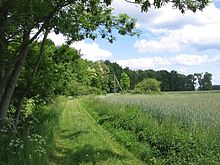Edge of the forest

A forest edge is the transition zone ( ecotone ) from closed forest to unwooded areas.
If it is a natural forest edge for climatic reasons, one speaks of the tree line .
The edge of the forest in maps
In topographic maps ( maps ) forest areas are usually represented by a soft green tone. The forest edges are - like other content - mostly recorded from aerial photographs , sometimes also measured terrestrially . However, they represent a “snapshot” because almost every forest has a tendency to expand or clearings slowly grow over. In addition, it is difficult to determine the edge of the forest if it turns into bush forest or if the tree density is only slowly decreasing. The differences of opinion here are often a few tens of meters. Some cartographers also prefer to depict small “island areas”, while others - depending on the scale of the map - draw generalized , connected lines.
For special examinations, aerial photos or satellite images are often used without the maps being revised in this regard. Cadastral plans cannot show the "current status", as they are only continued at longer intervals for cost reasons and cultural boundaries are not legally binding.
Edge of the forest and biology

At the edge of the forest - however you define it precisely - not only the flora changes , but also the fauna and the type of soil . Many animal species prefer the edges of the forest rather than the interior of the forest because they have both a protective function and light - see for example tree pipit and dunnock . At the edge of the forest there are often different trees than inside, also hedge plants , raspberries and low-growing plants are piling up. The gentler the transition from the open landscape to the forest (for example through young wood or bushes), the lower the risk that the wind will blow under the treetops and uproot the outer rows of trees in a storm. The design and maintenance of the edge of the forest is therefore very important in forestry in the course of silviculture .
Hunters also use the edge of the forest to observe and hunt game , especially from high seats .
An ideal, fully grown forest edge is divided from the outside to the inside into herb fringes , shrub belts and forest mantles - the latter is used to describe trees with a crown that extends far down the corridor.
There are two different types of forest edge, both of which put forest protection (wind protection) in the foreground: the outer edge of the forest (where fields, fields, generally large open spaces in the forest) and the inner edge of the forest (where small clearings, wild fields or somewhat wider ones) Forest roads).
In criminal cases, the composition of the living being communities can help to distinguish the interior of the forest from the exterior and the edge.
literature
- Thomas Coch, Hermann Hondong: Forest edge care . Basics and concepts. 21 tables. Practical Nature Conservation Series . Neumann, Radebeul 1995, ISBN 3-7402-0150-9 .
- Beinlich, B., Gockel, HA & Grawe, F. (2014): Medium forest-like forest edge design - economy and ecology in harmony. - ANLiegen Natur 36 (1): 61–65, running. PDF 0.7 MB.
Web links
Individual evidence
- ↑ Edge of the forest - habitat full of surprises. In: waldwissen.net. Retrieved May 19, 2016 .
- ↑ Waldmantel - Lexicon of Geography. In: Spektrum.de. Retrieved May 19, 2016 .
- ↑ Duden - forest coat. In: duden.de. Retrieved May 19, 2016 .
- ↑ Anja Fiedler, Markus Halbach, Bradley Sinclair & Mark Benecke (2008) What is the Edge of a Forest? A Diversity Analysis of Adult Diptera Found on Decomposing Piglets inside and on the Edge of a Western German Woodland inspired by a Courtroom Question (How is a forest edge defined? An investigation of adult Diptera on decomposing pigs inside and on the edge of a forest, inspired by a court hearing in western Germany). Entomology Today 20: 173–191; Retrieved on July 26, 2020